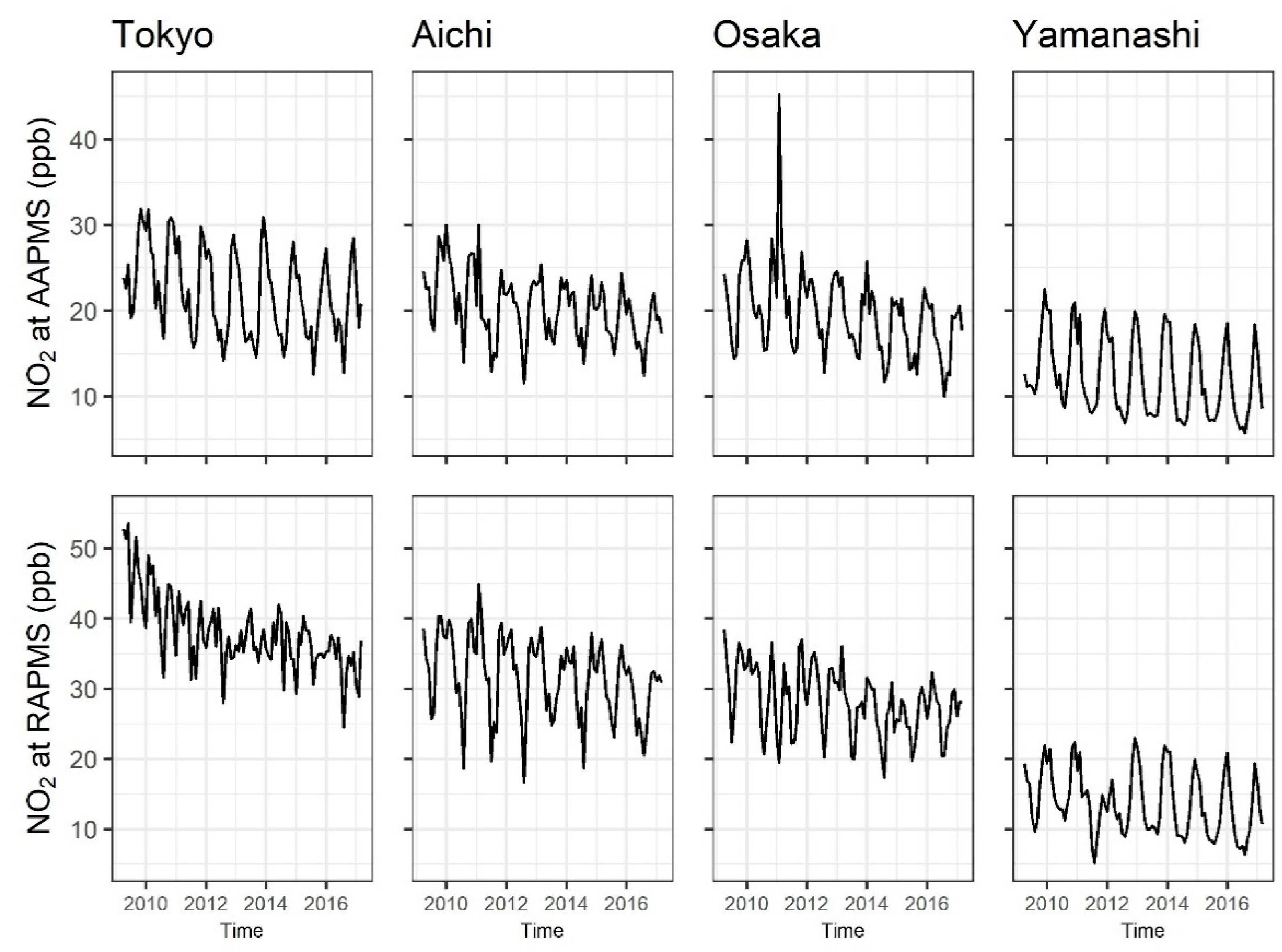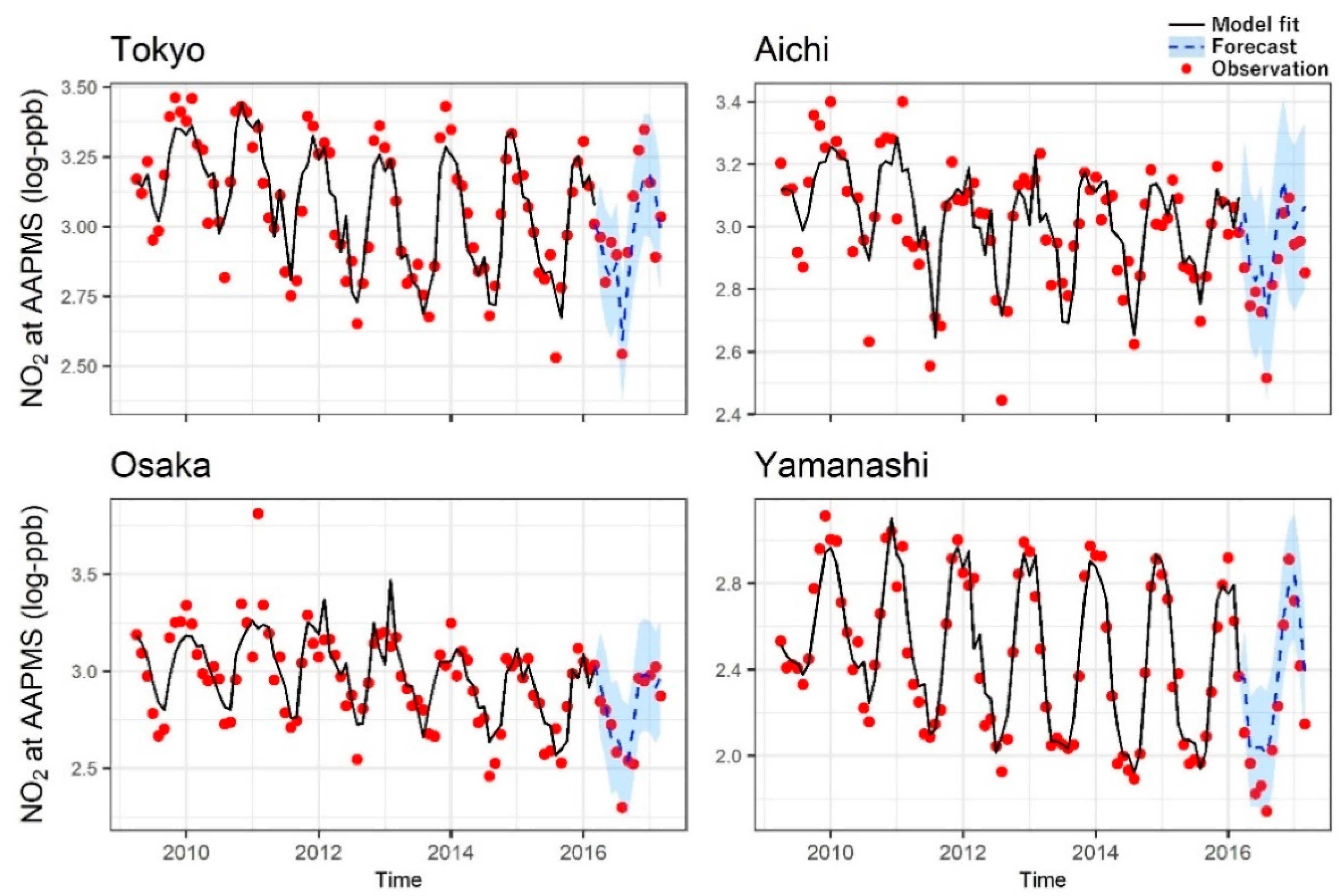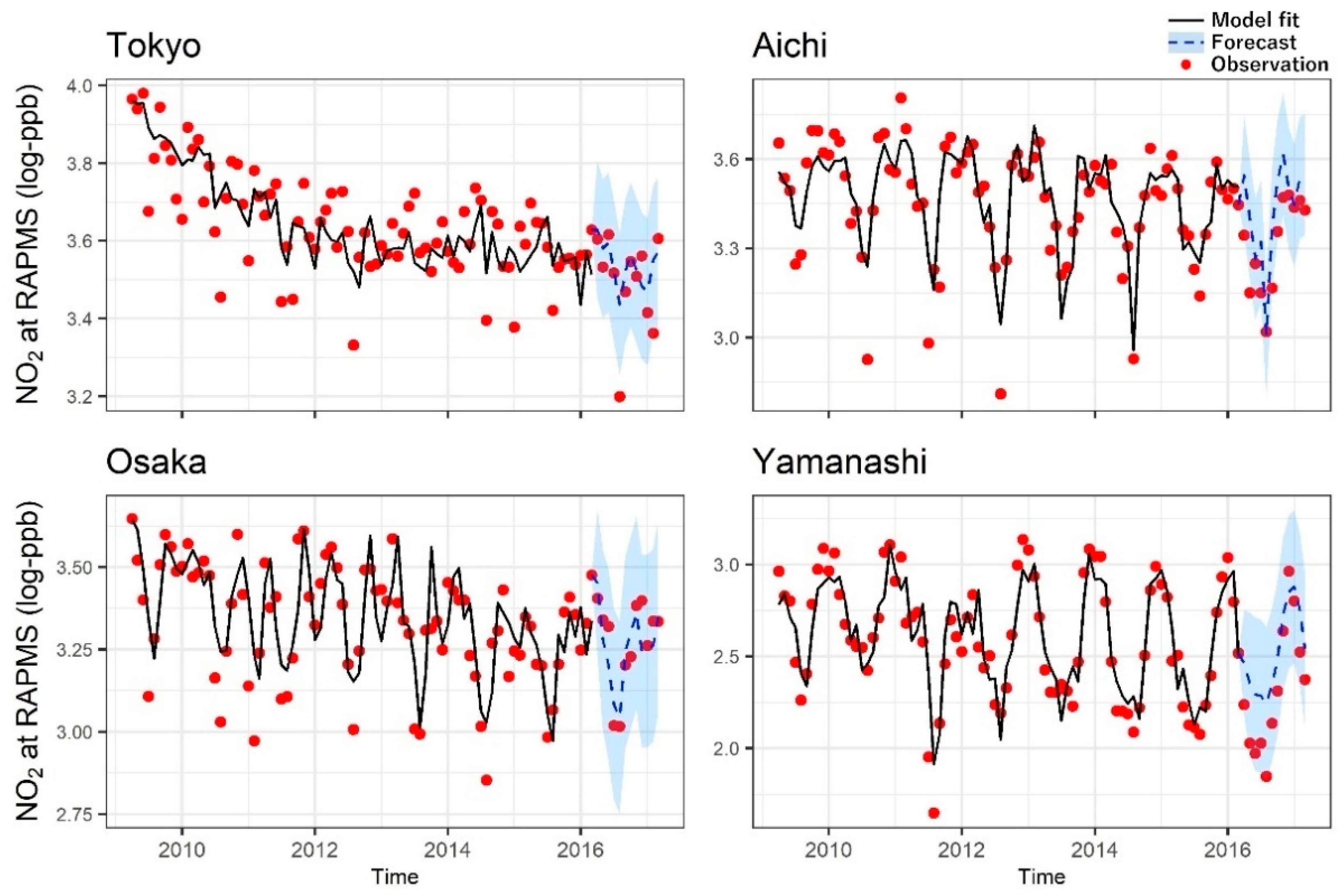Time Series Analysis of Climate and Air Pollution Factors Associated with Atmospheric Nitrogen Dioxide Concentration in Japan
Abstract
:1. Introduction
2. Materials and Methods
2.1. Study Area
2.2. Data Collection
2.3. Statistical Analysis
2.3.1. Descriptive Analysis
2.3.2. Time Series Prediction Model for NO2 (SARIMAX Model)
3. Results
3.1. Descriptive Analysis (NO2 Dynamics in April 2009–March 2017)
3.2. Climate and Air Pollution Factors Associated with Nitrogen Dioxide (NO2) Concentration at Ambient Air Pollution Monitoring Station (AAPMS)
3.3. Climate and Air Pollution Factors Associated with Nitrogen Dioxide (NO2) Concentration at Roadside Air Pollution Monitoring Station (RAPMS)
4. Discussion
5. Conclusions
Supplementary Materials
Author Contributions
Funding
Acknowledgments
Conflicts of Interest
References
- United States Environmental Protection Agency. Integrated Science Assessment for Oxides of Nitrogen—Health Criteria; EPA: Research Triangle Park, NC, USA, 2016.
- Liu, Q.; Wang, W.; Jing, W. Indoor air pollution aggravates asthma in Chinese children and induces the changes in serum level of miR-155. Int. J. Environ. Health Res. 2019, 29, 22–30. [Google Scholar] [CrossRef] [PubMed]
- Puklová, V.; Žejglicová, K.; Kratěnová, J.; Brabec, M.; Malý, M. Childhood respiratory allergies and symptoms in highly polluted area of Central Europe. Int. J. Environ. Health Res. 2019, 29, 82–93. [Google Scholar] [CrossRef] [PubMed]
- Deng, Q.; Lu, C.; Li, Y.; Sundell, J.; Norbäck, D. Exposure to outdoor air pollution during trimesters of pregnancy and childhood asthma, allergic rhinitis, and eczema. Environ. Res. 2016, 150, 119–127. [Google Scholar] [CrossRef] [PubMed]
- Ministry of the Environment, Government of Japan. Status of Air Pollution, 2018. Available online: http://www.env.go.jp/air/osen/jokyo_h30/index.html (accessed on 16 July 2020).
- Ohyama, M.; Nakajima, T.; Minejima, C.; Azuma, K.; Oka, K.; Itano, Y.; Kudo, S.; Takenaka, N. Association between indoor nitrous acid, outdoor nitrogen dioxide, and asthma attacks: Results of a pilot study. Int. J. Environ. Health Res. 2019, 29, 632–642. [Google Scholar] [CrossRef] [PubMed]
- Wang, L.; Wen, L.; Xu, C.; Chen, J.; Wang, X.; Yang, L.; Wang, W.; Yang, X.; Sui, X.; Yao, L.; et al. HONO and its potential source particulate nitrite at an urban site in North China during the cold season. Sci. Total Environ. 2015, 538, 93–101. [Google Scholar] [CrossRef] [PubMed]
- Dales, R.; Burnett, R.T.; Smith-Doiron, M.; Stieb, D.M.; Brook, J.R. Air pollution and sudden infant death syndrome. Pediatrics 2004, 113, e628–e631. [Google Scholar] [CrossRef] [PubMed] [Green Version]
- Linn, W.S.; Szlachcic, Y.; Henry, G.; Kinney, P.L.; Berhane, K.T. Air pollution and daily hospital admissions in Metropolitan Los Angeles. Environ. Health Perspect. 2000, 108, 427–434. [Google Scholar] [PubMed]
- Morgan, G.; Corbett, S.; Wlodarczyk, J.; Lewis, P. Air pollution and daily mortality in Sydney, Australia, 1989 through 1993. Am. J. Public Health 1998, 88, 759–764. [Google Scholar] [CrossRef] [PubMed] [Green Version]
- Sjödin, Å.; Ferm, M. Measurements of nitrous acid in an urban area. Atmos. Environ. 1985, 19, 985–992. [Google Scholar] [CrossRef]
- Oka, K. Measurement of Gaseous Nitrous Acid at Osaka Urban Site. Bull. Res. Inst. Environ. Agric. Fish. Osaka Prefect. Gov. 2008, 1, 13–21. [Google Scholar]
- Chan, W.H.; Nordstrom, R.J.; Calvert, J.G.; Shaw, J.H. Kinetic Study of HONO Formation and Decay Reactions in Gaseous Mixtures. Environ. Sci. Technol. 1976, 10, 674–682. [Google Scholar] [CrossRef]
- Pitts, J.N.; Winer, A.M.; Harris, G.W. Trace nitrogenous species in urban atmospheres. Environ. Health Perspect. 1983, 52, 153–157. [Google Scholar] [CrossRef] [PubMed]
- Ohyama, M.; Horie, I.; Isohama, Y.; Azuma, K.; Adachi, S.; Minejima, C.; Takenaka, N. Effects of nitrous acid exposure on baseline pulmonary resistance and Muc5ac in rats. Inhal. Toxicol. 2018, 30, 149–158. [Google Scholar] [CrossRef] [PubMed]
- World Health Organization. WHO Air Quality Guidelines for Particulate Matter, Ozone, Nitrogen Dioxide and Sulfur Dioxide; WHO: Geneva, Switzerland, 2005; Volume 195. [Google Scholar]
- Statistics Bureau, Ministry of Internal Affairs and Communications Japan. Final Report of 2015, Population and Households of Japan. Available online: http://www.stat.go.jp/english/data/kokusei/2015/final_en/final_en.html#Summary (accessed on 16 July 2020).
- Japan Meteorological Agency. Meteorological Data Download. Available online: https://www.data.jma.go.jp/gmd/risk/obsdl/index.php (accessed on 16 July 2020).
- Hyndman, R.J.; Athanasopoulos, G. ARIMA models. In Forecasting: Principles and Practice; OTexts: Melbourne, Australia, 2018. [Google Scholar]
- Box, G.E.P.; Jenkins, G.M.; Reinsel, G.C.; Ljung, G.M. Time Series Analysis: Forecasting and Control, 5th ed.; John Wiley & Sons, Inc.: Hoboken, NJ, USA, 2016; ISBN 9781118675021. [Google Scholar]
- Hyndman, R.J. Yeasmin Khandakar Automatic Time Series Forecasting: The forecast Package for R. J. Stat. Softw. 2008, 27, 22. [Google Scholar] [CrossRef] [Green Version]
- R Core Team. R: A Language and Environment for Statistical Computing; R Foundation for Statistical Computing: Vienna, Austria, 2020. [Google Scholar]
- Ministry of Land Infrastructure Transport and Tourism. National Transportation Census, 2015. Available online: https://www.mlit.go.jp/road/census/h27/index.html (accessed on 16 July 2020).
- Kuprov, R.; Eatough, D.J.; Cruickshank, T.; Olson, N.; Cropper, P.M.; Hansen, J.C. Composition and secondary formation of fine particulate matter in the Salt Lake Valley: Winter 2009. J. Air Waste Manag. Assoc. 2014, 64, 957–969. [Google Scholar] [CrossRef] [PubMed] [Green Version]
- Trinh, H.T.; Imanishi, K.; Morikawa, T.; Hagino, H. Gaseous nitrous acid (HONO) and nitrogen oxides (NOx) emission from gasoline and diesel vehicles under real-world driving test cycles. J. Air Waste Manage. Assoc. 2017, 67, 412–420. [Google Scholar] [CrossRef] [PubMed] [Green Version]
- Kaiser, E.W.; Wu, C.H. A kinetic study of the gas phase formation and decomposition reactions of nitrous acid. J. Phys. Chem. 1977, 81, 1701–1706. [Google Scholar] [CrossRef]



| AAPMS | RAPMS | |||||||
|---|---|---|---|---|---|---|---|---|
| Month | Tokyo | Aichi | Osaka | Yamanashi | Tokyo | Aichi | Osaka | Yamanashi |
| January | 26.5 (2.0) | 22.2 (3.5) | 22.9 (2.9) | 17.8 (1.6) | 34.5 (3.1) | 34.3 (2.2) | 28.0 (3.5) | 18.5 (3.0) |
| February | 25.2 (4.1) | 23.0 (3.6) | 24.6 (8.6) | 16.3 (3.0) | 37.9 (6.2) | 36.7 (4.2) | 28.6 (4.7) | 17.8 (3.2) |
| March | 23.1 (2.4) | 21.9 (2.9) | 22.5 (3.0) | 12.3 (2.7) | 38.8 (3.7) | 36.2 (3.7) | 30.9 (3.5) | 14.4 (2.5) |
| April | 21.1 (2.7) | 21.0 (2.3) | 20.8 (2.7) | 10.6 (1.6) | 41.5 (5.8) | 33.6 (3.0) | 32.1 (3.5) | 13.3 (3.0) |
| May | 18.8 (2.2) | 18.4 (2.3) | 18.7 (1.7) | 8.7 (1.6) | 39.4 (5.4) | 29.5 (3.5) | 29.5 (3.7) | 11.6 (3.3) |
| June | 19.6 (3.6) | 19.0 (2.5) | 17.4 (2.9) | 8.7 (2.2) | 42.4 (5.0) | 29.0 (2.8) | 28.1 (2.9) | 11.2 (3.1) |
| July | 18.2 (1.1) | 16.7 (2.0) | 16.1 (2.1) | 8.1 (1.5) | 37.2 (3.4) | 24.7 (2.3) | 21.7 (1.8) | 9.5 (2.0) |
| August | 15.2 (2.3) | 14.4 (2.0) | 13.8 (2.2) | 7.7 (1.4) | 32.7 (6.3) | 21.8 (3.7) | 21.1 (2.6) | 8.4 (2.0) |
| September | 18.2 (3.6) | 18.0 (2.8) | 14.3 (1.6) | 8.8 (1.7) | 37.6 (6.5) | 28.3 (4.0) | 26.6 (2.9) | 9.9 (1.7) |
| October | 22.5 (4.9) | 22.2 (3.5) | 17.6 (3.8) | 12.1 (2.4) | 38.6 (4.8) | 34.8 (4.3) | 30.5 (4.2) | 12.7 (2.1) |
| November | 27.8 (3.0) | 24.4 (2.1) | 23.3 (3.3) | 16.9 (2.5) | 38.2 (5.0) | 37.2 (2.8) | 32.5 (3.4) | 17.7 (2.7) |
| December | 28.9 (1.8) | 23.1 (2.2) | 22.8 (2.5) | 19.5 (1.9) | 36.8 (2.7) | 34.2 (1.7) | 29.0 (2.9) | 20.1 (3.0) |
| Model 1 (SARIMA/ SARIMAX) | AAPMS | RAPMS |
|---|---|---|
| Coefficient 2 (95%CI) | ||
| Tokyo | ||
| SARIMA | NA | NA |
| Temperature | −0.022 (−0.029, −0.015) | −0.001 (−0.005, 0.003) |
| Humidity | 0.004 (−0.001, 0.008) | 0.002 (−0.001, 0.004) |
| Wind speed | −0.181 (−0.242, −0.120) | −0.297 (−0.344, −0.251) |
| Solar radiation | −0.021 (−0.033, −0.009) | −0.002 (−0.01, 0.005) |
| Sunshine duration | −0.018 (−0.037, 0.001) | −0.021 (−0.039, −0.003) |
| NO | 0.024 (0.016, 0.031) | 0.006 (0.005, 0.008) |
| O3/AO 3 | −0.003 (−0.009, 0.002) | −0.003 (−0.012, 0.001) |
| Aichi | ||
| SARIMA | NA | NA |
| Temperature | −0.015 (−0.020, −0.009) | −0.016 (−0.022, −0.009) |
| Humidity | −0.003 (−0.010, 0.004) | −0.005 (−0.010, 0.000) |
| Wind speed | −0.270 (−0.343, −0.196) | −0.169 (−0.238, −0.100) |
| Solar radiation | −0.019 (−0.031, −0.007) | −0.002 (−0.014, 0.011) |
| Sunshine duration | −0.013 (−0.034, 0.008) | −0.002 (−0.020, 0.016) |
| NO | 0.020 (0.013, 0.028) | 0.009 (0.007, 0.012) |
| O3/AO 3 | −0.001 (−0.008, 0.005) | 0.001 (−0.005, 0.007) |
| Osaka | ||
| SARIMA | NA | NA |
| Temperature | −0.022 (−0.026, −0.018) | −0.011 (−0.013, −0.008) |
| Humidity | −0.010 (−0.019, −0.001) | −0.006 (−0.012, −0.001) |
| Wind speed | −0.306 (−0.413, −0.199) | −0.257 (−0.317, −0.198) |
| Solar radiation | 0.002 (−0.025, 0.029) | 0.01 (−0.006, 0.026) |
| Sunshine duration | 0.061 (0.031, 0.091) | 0.025 (0.003, 0.047) |
| NO | 0.033 (0.027, 0.039) | 0.015 (0.012, 0.018) |
| O3/AO 3 | −0.002 (−0.009, 0.005) | −0.006 (−0.011, −0.001) |
| Yamanashi | ||
| SARIMA | NA | NA |
| Temperature | −0.012 (−0.034, 0.010) | −0.031 (−0.038, −0.024) |
| Humidity | 0.010 (0.006, 0.013) | 0.005 (0.001, 0.010) |
| Wind speed | −0.198 (−0.251, −0.144) | −0.120 (−0.208, −0.032) |
| Solar radiation | −0.016 (−0.029, −0.004) | −0.005 (−0.022, 0.012) |
| Sunshine duration | −0.025 (−0.043, −0.006) | 0.012 (−0.008, 0.032) |
| NO | 0.034 (0.021, 0.047) | 0.038 (0.025, 0.050) |
| O3/AO 3 | −0.007 (−0.012, −0.002) | −0.009 (−0.015, −0.005) |
Publisher’s Note: MDPI stays neutral with regard to jurisdictional claims in published maps and institutional affiliations. |
© 2020 by the authors. Licensee MDPI, Basel, Switzerland. This article is an open access article distributed under the terms and conditions of the Creative Commons Attribution (CC BY) license (http://creativecommons.org/licenses/by/4.0/).
Share and Cite
Miyama, T.; Matsui, H.; Azuma, K.; Minejima, C.; Itano, Y.; Takenaka, N.; Ohyama, M. Time Series Analysis of Climate and Air Pollution Factors Associated with Atmospheric Nitrogen Dioxide Concentration in Japan. Int. J. Environ. Res. Public Health 2020, 17, 9507. https://doi.org/10.3390/ijerph17249507
Miyama T, Matsui H, Azuma K, Minejima C, Itano Y, Takenaka N, Ohyama M. Time Series Analysis of Climate and Air Pollution Factors Associated with Atmospheric Nitrogen Dioxide Concentration in Japan. International Journal of Environmental Research and Public Health. 2020; 17(24):9507. https://doi.org/10.3390/ijerph17249507
Chicago/Turabian StyleMiyama, Takeshi, Hiroshi Matsui, Kenichi Azuma, Chika Minejima, Yasuyuki Itano, Norimichi Takenaka, and Masayuki Ohyama. 2020. "Time Series Analysis of Climate and Air Pollution Factors Associated with Atmospheric Nitrogen Dioxide Concentration in Japan" International Journal of Environmental Research and Public Health 17, no. 24: 9507. https://doi.org/10.3390/ijerph17249507






